|


Published by Yakimono.net August 2002
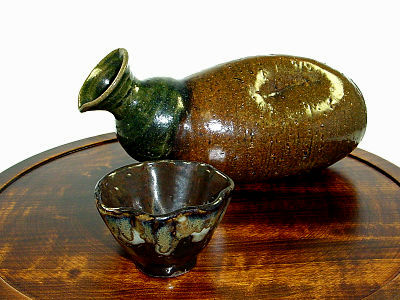
One of the greatest pleasures in drinking sake for me is using an interesting selection of shuki (sake vessels) in order to create a stimulating atmosphere. There are just so many shapes and styles! It doesn't matter if I'm with a group of people or sitting alone at home -- the ambience all comes together with the selection of items in which one enjoys the "ambrosia of the gods."
Ambience is also what many traditional Japanese homes have and modern ones do not -- it is a great loss to Japan when so many fine older buildings are razed in order to put up some new convenient store, parking lots, funky apartment buildings, or the worst of them all, a prefabricated home made with unnatural materials that have given way to many health problems. What is happening to the beauty of Japanese architecture?!
One portion of a traditional home that I simply adore is the irori (open-hearth). What a fine space. A fire pit surrounded by wood, thick straw mats to sit on, and the mysterious aura of light that the irori creates -- it's almost like a movie set. Can you think of a better place to sit and enjoy a drink? An irori is almost like a Japanese version of King Arthur's Round Table where no one is at the head and all have an equal voice. Lord knows we need to share a meal or drink with our families with more communication and less with the TV on!
|
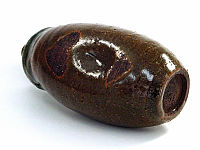
View of tokkuri's bottom
|
|
Now if I was sitting around an irori in the winter and needed some atsukan (hot sake), I can think of no better way than to warm the sake up in a kamo-dokkuri (duck tokkuri). Just stand it up in the ash and let the warm air go in. Now kamo-dokkuri are not so common and I can think of only a few contemporary potters whose kamo-dokkuri I've ever seen. Those that come to mind are Kohyama Yasuhisa and Nakazato Takashi -- I'm sure there are others.
The most popular style of kamo-dokkuri originated in Toyama Prefecture with Kosugi-yaki, which started around 1816 and died out around 1908. I must say that I looked in three books and each had a slightly different date for the beginning and end of Kosugi-yaki. Oh well, what's a few years in eternity.
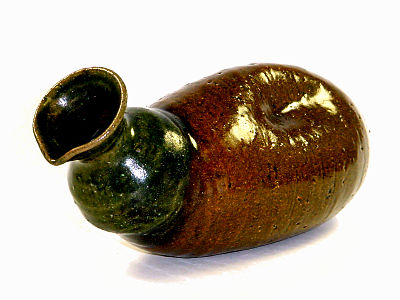
The kamo-dokkuri (shown above) has the green glaze and ame-yu (caramel, amber) glaze typical of Kosugi-yaki, but the neck is a bit short, so I wonder if it might not be a Kofu-yaki (another style of kamo-dokkuri). Kofu-yaki did start after Kosugi-yaki and the feeling of this piece is a bit later -- Kofu-yaki began around 1910. Whatever the case, it is a funky little tokkuri that certainly helps to create a fine ambience.
So does the small sake cup pictured below and the beautiful box it came in. The hai (cup) has a pleasing foliated lip and a dark chocolaty glaze that reminds me of a tsubaki-de (rusty reds/browns) guinomi. Over the lip drips a Monet-like impressionistic glaze that gives the hai a nice contrast with the dusky interior.
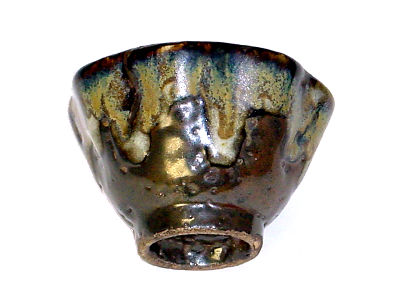
Since the hai is quite small I would most likely pour in a fine ginjo -- these days I've really come to like Maihime sake from Nagano, and sip slowly. A regular junmai-shu requires a larger hai because I usually take big sips and I would have to keep constantly filling such a small hai if I were to drink a standard sake. Indeed, the size, and ambience, of a sake cup dictates what type of sake should be enjoyed.
The kanji on the box reads "Echu-Kosugi-yaki Hai"
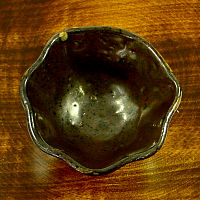
A look inside the sake cup
|